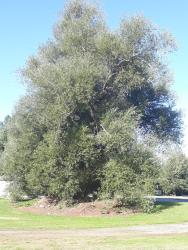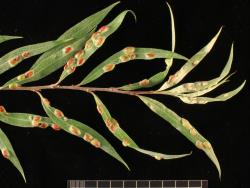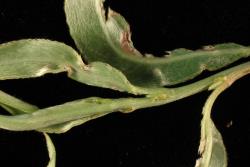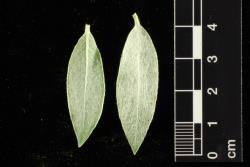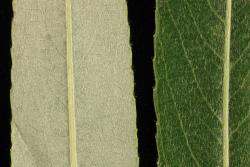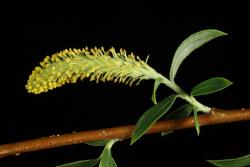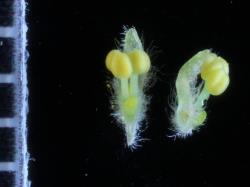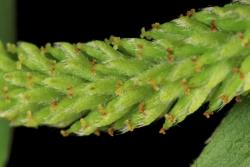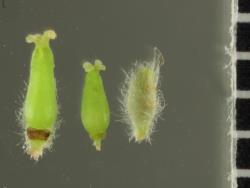- = Salix caerulea Sm., Engl. Bot. 34, Pl. 2431 (1812)
- ≡ Salix alba var. caerulea (Sm.) Sm., Engl. Fl. 4, 231 (1828) – as β S. caerulea
- = Salix alba var. calva G.Mey., Chloris Han. 487 (1836) – as spielart a. calva
Trees to 20(–25) m tall with an erect form; trunk to 1 m diameter, bark dull grey, fissured. Current year's branchlets densely long-silky, hairs persisting, occasionally not persisting, 2.6–2.9 mm diameter. Year-old branchlets yellow-brown (UCL72) to olive-brown (UCL95) to red-brown (UCL43), with moderately dense short-silky hairs. Bud scales 4.5–6.8 mm long, 2.0–2.5 mm wide, 1.2–1.6 mm deep, lanceolate, with 2 keels, red-brown (UCL43) to mid-brown (UCL58), with moderately dense, short-silky hairs, or glabrous, pinky-red. Stipule 2–8 mm long, very narrowly asymmetrically ovate, not persisting. Petiole 8–18 mm long, densely short-silky hairs to glabrous, adaxial groove absent, base pale yellow or pinky-red, glands absent or 1–2, black or brown. Emerging leaves green, with moderately dense to dense long-silky hairs. Proximal leaves entire or toothed. Leaf lamina 83–158 mm long, 11–27 mm wide, length to width ratio 5.0–7.9:1, very narrowly ovate, occasionally elliptical or elliptical-oblong, not or weakly falcate; base cuneate; apex very narrowly acute to acuminate; leaf galls absent or few to abundant, usually red, sometimes yellow, rarely black; orange rust not present on leaves in late summer, margins densely serrulate, flat; upper lamina surface smooth or with midvein and sometimes secondary veins raised, medium-glossy, sparsely to densely long-silky hairy, stomata dense; lower lamina with surface midvein usually raised, other veins visible or not, distinctly glaucous, moderately dense to dense long-silky hairs. Catkins male or female, emergence coetaneous with leaves. Flowering branch 34–67 mm long with 4–7 leaves plus 0–1 cataphylls. Male catkin 30–50 mm long, 5–10 mm diameter; catkin rachis usually visible between flowers. Female catkin 23–39 mm long, 3.5–8 mm diameter; catkin rachis visible or not between flowers. Flower bract (1.2)2.0–3.0 mm long, 0.5–1.1 mm wide, pale green or pale yellow-green, channelled and curved inwards on the long axis; apex acute to obtuse, moderately densely villous all over or hairs confined to the lower half, female bract deciduous. Male nectaries 2, 0.3–0.7 × 0.3–0.6 mm, yellow. Stamens 2, filaments free, hairs present at filament base; anthers 0.6–1.2 mm long, yellow. Female nectaries 1, 0.3–0.5 mm long, 0.4–0.7 mm wide, yellow; ovary 1.6–2.7 mm long, glabrous, equal to or slightly longer than the flower bract; stipe 0.3–0.4 mm long; undivided style 0.2–0.3 mm long; style arms lobed up to ⅓ their length, pale green or yellow-green, sometimes becoming tinged red.
The mature tree has a characteristic shape, described by Meikle (1984) as a tall, graceful tree 10–25 m tall, with main branches forming a narrow, pointed or truncate crown, or a number of pointed 'turrets'. Young leaves are moderately densely to densely long-silky hairy on both surfaces, often the surfaces equally densely hairy; this gives the leaves a silvery look, which is distinctive. Leaf hairs persist more than in other tree willows, and this silvery look persists throughout the summer. Current year's branchlets are densely short-silky hairy; previous years' branchlets retain some hairs. Leaf galls are common and abundant and are tinted red to varying degrees. Leaves are very narrowly ovate, margins densely serrulate.
Most similar to Salix ×fragilis f. fragilis. As a mature tree, S. alba is taller than S. ×fragilis f. fragilis and doesn't have the flat-topped, wind-shorn crown commonly seen in S. ×fragilis f. fragilis. It also differs from S. ×fragilis f. fragilis in having smaller leaves, most noticeable in mid- to late summer, when S. ×fragilis f. fragilis produces large leaves (lamina up to 197 × 48 mm versus up to 158 × 27 mm in S. alba). The long-silky hairs on the young leaves of S. alba are much denser than in S. ×fragilis f. fragilis, and they persist, while in S. ×fragilis f. fragilis the hairs are almost completely absent by mid-summer. Both have abundant red leaf galls; this is not a difference between the two.
Similar to Salix matsudana in tree size and form, but S. matsudana lacks dense, long-silky hairs on the leaf surfaces. Salix matsudana is uncommon in cultivation while S. alba is very common. Similar also to S. matsudana × S. alba in tree form, and both are used in shelter-belt plantings, S. matsudana × S. alba more so. Again, the most obvious difference between the two is the silvery look of S. alba leaves, although clones vary considerably in the density of hairs on mature leaves.
Similar to Salix ×fragilis f. vitellina and differing mainly in the 1-year-old branchlet colour, olive-green rather than dark yellow to orange-yellow to orange-red, but also in flower bract length being shorter (3.0–4.0 mm long in S. fragilis f. vitellina versus 0.6–3.0 mm long in S. alba).
Auckland (Taumarunui 1994); Southern North Island (Hutt River 1949–1953), Marlborough (Fairhall Creek 1976); Canterbury (Lewis Pass 1988, Hurunui River 1941, Waitohi River 1963, Coutts Island 1980, Opawa 1963, Hornby 1954–1980, Travis Wetland 2005, Selwyn River 1964, Ashburton 1955), Southland (Riverton 1973).
Common in cultivation throughout New Zealand.
First collection: Hurunui River near Hotel, collector unknown, 22 October 1941, CHR 48296, with no indication whether the plant was wild or cultivated. Otherwise, Smart Bros. quarry, Hornby [Christchurch], "bottom of large shingle pit", A. J. Healy 54/469, 25 Nov 1955, CHR 88916.
First publication: The earliest mention of naturalisation is by Kirk (1882, p. 292): "Salix alba, L. Naturalized on the banks of the Northern Wairoa and Waikato." It is possible that these plants were S. ×fragilis.
Flowering: Late September–early November, but one clone at Aokautere (PN655) flowers later, starting in mid-October and finishing in early December.
Tetraploid, 2n = 76 (CCDB based on 32 counts), provisionally confirmed by flow cytometry using PN361 and PN357.



